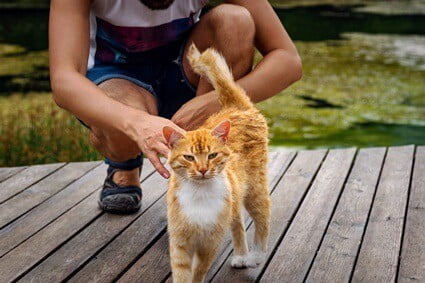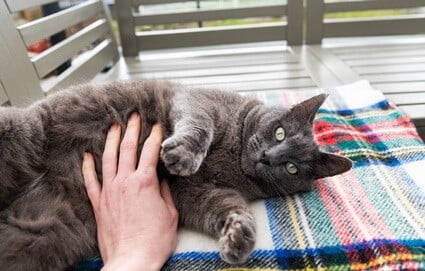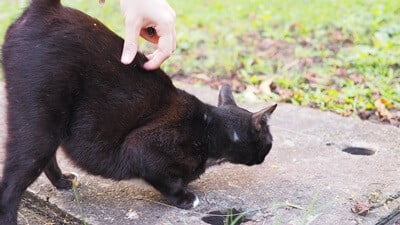Tickling is a sensation caused by stimulating certain nerve receptors, leading to an involuntary reaction. As humans, we tend to associate tickling with laughter. While cats cannot laugh, they can still respond positively or negatively, depending on which body part has been tickled.
Most cats are ticklish, responding immediately to being tickled on the paw pads, back, belly, and tail. Cats are also sensitive to tickling around their ears, neck, and chin. Some cats enjoy the experience and lean into the gesture while meowing, while others hate it and leave or show hostility.
To test if your cat is ticklish, start with spots like the back and around the neck. You can switch to more risky areas, such as around the tail, ears, and paws. The belly is highly sensitive and gives your cat easy access to close its talons around you, so proceed carefully.
How To Tell If Your Cat Is Ticklish
According to Companion Animal Medicine, cats have boundaries on how much physical touch they’re comfortable with. Some cats hate being tickled and respond with clawing and biting, while others like being tickled in certain places or by certain people and not others.
Why is my cat so ticklish? Why isn’t my cat ticklish? No two cats will be the same, so you need to check for signs to determine how your cat feels.
Cats have no reservations about letting you know if they’re having a bad time. This makes it easy to tell when your cat dislikes a tickle session. It’ll likely respond by moving away from you, biting, or using its claws on your hand. If your cat hisses at you, it wants you to stop.
High-pitched meows or trilling are positive reactions that show that your cat enjoys the experience. It may lean into your touch position so that you can tickle other spots and purr.
Do Cats Laugh When Tickled?
Cats lack the vocal capacity to laugh, so they’ll be unable to do so when tickled.
According to the Journal of Visualized Experiments, this is true for most animals, including rats. Nonetheless, tickling still has a positive effect on animals.
Instead of laughing or smiling, cats will react based on how they feel about the tickle session. If the cat likes it, it may purr or meow loudly, which can be counted as the feline equivalent of a laugh.
If it dislikes it, it may react like a human would in that situation and move away from you. If you persist, or the cat is very ticklish, it may bat at your hand or nip you.
In some cases, cats misinterpret tickling as the sensation caused by parasites, especially if it has had a flea problem recently. Try tickling your cay with slightly more pressure.
How To Tickle A Cat
According to Current Biology, cats will seek out tickles by initiating the physical interaction, which is done through head-butting or nuzzling you.
If the cat wants to leave at any time, allow this, or the cat may get overstimulated. This can lead to agitation or result in the cat escalating into playtime. While that sounds like a good thing, remember that cats often play with their teeth and claws.
If the tickling session is going well, you can get creative. Sometimes cats get bored if you continue the same motions. Once you start, change how you’re tickling after a while.
Keep the tickle sessions quick and with purpose. Tickling your cat too much or for too long can lead to them getting annoyed. These should be fun, short sessions that improve the human-feline bond.
Where Are Cats’ Ticklish Spots?
Just as some people feel ticklish on their feet, while others on their stomachs, cats have different ticklish spots. You can learn where these are over several tickling sessions with your cat.
There are some common spots where all cats probably feel ticklish, including the following:
- Paw pads
- Stomachs
- Back
- Tail
- Below the chin
Some cats are ticklish between the ears but, whether this is positive or negative depends on the cat.

Are Cats Ticklish On Their Paws?
Feline paws are naturally sensitive and responsible for the following:
- Sensing vibrations from the ground
- Absorbing shock if the cat falls from a height
- Heat insulation
- Perspiration
Most cats dislike their paws being handled unless they’re well-socialized and used to being touched everywhere. Your cat may dislike being tickled here. Even if it likes tickling elsewhere, the sensitivity of the paws may lead to overstimulation when tickled.
If your cat is sleeping with its paw pads exposed, this is a sign that it trusts and feels comfortable around you. If you tickle its paws without any warning, it may be a violation of the trust it places in you.
Some cats enjoy the hypersensitivity of their paws and find it enjoyable to have them brushed, rubbed, or tickled. This is rare, so you should tread carefully.
Are Cats Ticklish On Their Back?
Many cats like being tickled on the back as there’s more fur and fewer nerve endings in this area.
There’s little danger of overstimulation when petted, rubbed, or tickled here, so the sensation can be pleasant rather than overwhelming.
Of course, this varies from cat to cat. If your cat enjoys being groomed, petted, or touched along its back, it’s likely to enjoy tickling. If your cat already avoids being touched on this spot, tickling will be a no-go.
In light of this, if you’re testing it out, start with a grooming brush. Pet your cat around the head and brush down its back when it gets more relaxed. If your cat doesn’t like it, it’ll bat away the brush or leave.
If your cat likes being tickled, it might roll over on its back after a while. Remember that a cat rolling onto its back is not an invitation to tickle its belly. It’s often a way for the cat to prepare to grab your hand, scratching and biting it. This may be done playfully, but it could still hurt.
Are Cats’ Ears Ticklish?
Most cats enjoy being tickled around the head and neck. However, the ears are a more delicate and somewhat private area that some cats prefer to remain untouched.
Anecdotal evidence from owners shows that tickling around the chin, neck, and base of the ears is often welcomed while tickling the middle or top of the ears is declined.
To find out, start behind the ears to find out how your cat responds; if it doesn’t mind, you can continue. From the ears, move down to the neck.

Are Cats’ Tails Ticklish?
Cats have a cluster of nerves just above their tails, making every sensation intense in this spot.
Since this area becomes overstimulated easily, you can annoy your cat when tickling here. With that said, if you do it right, most cats enjoy being tickled in this location.
This area is difficult for cats to reach on their own. If your tickle doubles as a scratch, cats will enjoy it. If your cat drops its head and front paws down to lift its butt, this is a sign that it’s enjoying itself.
It may release scent markers from the anal glands, which can be a compliment in cat-speak. According to the Research Institute in Semiochemistry and Applied Ethology, this behavior is only exhibited with other cats it likes. So, if your cat shows you its butt, this is a sign that it enjoys being tickled.
If the tail is still or swishing leisurely. If the tail moves from side to side deliberately, it’s best to stop. Cats wag their tails in this manner when they are unhappy.
Are Cats Ticklish On Their Belly?
As with paws, a cat’s stomach is highly sensitive. If you touch a cat’s belly unannounced, you’ll likely get an unfavorable reaction.
Whether it’s a sudden pounce to play with you or a scratch to warn you off, you’re running a risk by tickling a cat’s belly. Your cay may enjoy it, but it could feel vulnerable.
Much depends on how trusting and open your cat is. Cats that have been socialized from kittenhood may allow their owners to touch their bellies.
Even the most trusting cat is unlikely to let you tickle its stomach for more than a few minutes as the sensation can become uncomfortable.
Cats are ticklish on their paws, backs, bellies, tails, and ears. The question is, should you tickle it there? Move slowly and test how your cat feels about it. If it leans into the gesture, you can continue. If it shows signs of annoyance or moves away, it doesn’t enjoy tickling, so you should leave it alone.

